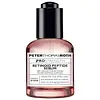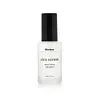What's inside
What's inside
 Key Ingredients
Key Ingredients

 Benefits
Benefits

 Concerns
Concerns

 Ingredients Side-by-side
Ingredients Side-by-side

C9-12 Alkane
SolventDimethicone
EmollientIsononyl Isononanoate
EmollientDimethyl Isosorbide
SolventTrisiloxane
Skin ConditioningCyclopentasiloxane
EmollientPolysilicone-11
Coco-Caprylate/Caprate
EmollientCaprylic/Capric Triglyceride
MaskingHydroxypinacolone Retinoate
Skin ConditioningPalmitoyl Hexapeptide-14
Skin ConditioningCeramide NP
Skin ConditioningHelianthus Annuus Seed Extract
Skin ConditioningHordeum Vulgare Extract
EmollientCucumis Sativus Extract
Skin ConditioningLaminaria Ochroleuca Extract
Skin ConditioningZingiber Officinale Root Extract
MaskingPhytosteryl Canola Glycerides
Skin ConditioningSodium Hyaluronate
HumectantSodium PCA
HumectantSqualane
EmollientTocopherol
AntioxidantLecithin
EmollientLinoleic Acid
CleansingOleic Acid
EmollientPalmitic Acid
EmollientStearic Acid
CleansingHydroxystearic Acid
CleansingTriolein
Skin ConditioningBisabolol
MaskingEthylhexyl Hydroxystearate
EmollientEthoxydiglycol
HumectantEthylhexylglycerin
Skin ConditioningWater
Skin ConditioningMica
Cosmetic ColorantPhenoxyethanol
PreservativeC9-12 Alkane, Dimethicone, Isononyl Isononanoate, Dimethyl Isosorbide, Trisiloxane, Cyclopentasiloxane, Polysilicone-11, Coco-Caprylate/Caprate, Caprylic/Capric Triglyceride, Hydroxypinacolone Retinoate, Palmitoyl Hexapeptide-14, Ceramide NP, Helianthus Annuus Seed Extract, Hordeum Vulgare Extract, Cucumis Sativus Extract, Laminaria Ochroleuca Extract, Zingiber Officinale Root Extract, Phytosteryl Canola Glycerides, Sodium Hyaluronate, Sodium PCA, Squalane, Tocopherol, Lecithin, Linoleic Acid, Oleic Acid, Palmitic Acid, Stearic Acid, Hydroxystearic Acid, Triolein, Bisabolol, Ethylhexyl Hydroxystearate, Ethoxydiglycol, Ethylhexylglycerin, Water, Mica, Phenoxyethanol
Water
Skin ConditioningMethylpropanediol
SolventGlycerin
Humectant1,2-Hexanediol
Skin ConditioningCaprylic/Capric Triglyceride
MaskingNiacinamide
SmoothingDioscorea Japonica Root Extract
Skin ConditioningPolysilicone-11
Raffinose
Skin ConditioningSaccharomyces Ferment Filtrate
HumectantXanthan Gum
EmulsifyingCentella Asiatica Extract
CleansingFicus Carica Fruit Extract
HumectantDiphenyl Dimethicone
EmollientTriethylhexanoin
MaskingMadecassoside
AntioxidantPolyquaternium-51
Skin ConditioningAloe Barbadensis Leaf Water
MaskingEthylhexylglycerin
Skin ConditioningParfum
MaskingOryza Sativa Extract
AbsorbentPiper Methysticum Leaf/Root/Stem Extract
Skin ConditioningAlgae Extract
EmollientEclipta Prostrata Leaf Extract
Skin ConditioningPanax Ginseng Berry Extract
Skin ConditioningMonascus Extract
Skin ConditioningGlycosyl Trehalose
Emulsion StabilisingHydrogenated Starch Hydrolysate
HumectantAdenosine
Skin ConditioningBiosaccharide Gum-1
HumectantPolyglyceryl-10 Myristate
Skin ConditioningHydrogenated Lecithin
EmulsifyingDisodium EDTA
Laureth-12
EmulsifyingLecithin
EmollientSodium Hyaluronate
HumectantDipropylene Glycol
HumectantArgania Spinosa Kernel Oil
EmollientCamellia Japonica Seed Oil
EmollientCamellia Sinensis Seed Oil
HumectantHelianthus Annuus Seed Oil
EmollientMacadamia Integrifolia Seed Oil
Skin ConditioningOlea Europaea Fruit Oil
MaskingSimmondsia Chinensis Seed Oil
EmollientBeta-Glucan
Skin ConditioningButyrospermum Parkii Butter
Skin ConditioningTocopherol
AntioxidantCeramide NP
Skin ConditioningFructooligosaccharides
HumectantPropylene Glycol
HumectantHydrolyzed Hyaluronic Acid
HumectantHydrogenated Phosphatidylcholine
EmulsifyingRetinol
Skin ConditioningCholesterol
EmollientCetyl Alcohol
EmollientStearyl Alcohol
EmollientCarbomer
Emulsion StabilisingAmmonium Acryloyldimethyltaurate/Vp Copolymer
Tromethamine
BufferingWater, Methylpropanediol, Glycerin, 1,2-Hexanediol, Caprylic/Capric Triglyceride, Niacinamide, Dioscorea Japonica Root Extract, Polysilicone-11, Raffinose, Saccharomyces Ferment Filtrate, Xanthan Gum, Centella Asiatica Extract, Ficus Carica Fruit Extract, Diphenyl Dimethicone, Triethylhexanoin, Madecassoside, Polyquaternium-51, Aloe Barbadensis Leaf Water, Ethylhexylglycerin, Parfum, Oryza Sativa Extract, Piper Methysticum Leaf/Root/Stem Extract, Algae Extract, Eclipta Prostrata Leaf Extract, Panax Ginseng Berry Extract, Monascus Extract, Glycosyl Trehalose, Hydrogenated Starch Hydrolysate, Adenosine, Biosaccharide Gum-1, Polyglyceryl-10 Myristate, Hydrogenated Lecithin, Disodium EDTA, Laureth-12, Lecithin, Sodium Hyaluronate, Dipropylene Glycol, Argania Spinosa Kernel Oil, Camellia Japonica Seed Oil, Camellia Sinensis Seed Oil, Helianthus Annuus Seed Oil, Macadamia Integrifolia Seed Oil, Olea Europaea Fruit Oil, Simmondsia Chinensis Seed Oil, Beta-Glucan, Butyrospermum Parkii Butter, Tocopherol, Ceramide NP, Fructooligosaccharides, Propylene Glycol, Hydrolyzed Hyaluronic Acid, Hydrogenated Phosphatidylcholine, Retinol, Cholesterol, Cetyl Alcohol, Stearyl Alcohol, Carbomer, Ammonium Acryloyldimethyltaurate/Vp Copolymer, Tromethamine
Ingredients Explained
These ingredients are found in both products.
Ingredients higher up in an ingredient list are typically present in a larger amount.
This ingredient is an emollient, solvent, and texture enhancer. It is considered a skin-softener by helping the skin prevent moisture loss.
It helps thicken a product's formula and makes it easier to spread by dissolving clumping compounds.
Caprylic Triglyceride is made by combining glycerin with coconut oil, forming a clear liquid.
While there is an assumption Caprylic Triglyceride can clog pores due to it being derived from coconut oil, there is no research supporting this.
Learn more about Caprylic/Capric TriglycerideCeramide NP is a type of ceramide.
Ceramides are intercellular lipids naturally found in our skin that bonds dead skin cells together to create a barrier. They are known for their ability to hold water and thus are a great ingredient for dry skin.
Ceramides are an important building block for our skin barrier. A stronger barrier helps the skin look more firm and hydrated. By bolstering the skin ceramides act as a barrier against irritating ingredients. This can help with inflammation as well.
If you would like to eat ceramides, sweet potatoes contain a small amount.
Read more about other common types of ceramides here:
Ceramide AP
Ceramide EOP
Ethylhexylglycerin (we can't pronounce this either) is commonly used as a preservative and skin softener. It is derived from glyceryl.
You might see Ethylhexylglycerin often paired with other preservatives such as phenoxyethanol. Ethylhexylglycerin has been found to increase the effectiveness of these other preservatives.
Lecithin is a term for a group of substances found in the cell membranes of plants, animals, and humans. They are made up of mixture of phospholipids.
This ingredient has emollient and emulsifying properties.
As an emollient, lecithen helps soften the skin and creates a barrier to keep moisture in.
As an emulsifier, it also helps prevent water and oil ingredients from separating. Lecithin can also help ingredients be better absorbed by the skin.
This is because the phospholipids in lecithin produce liposomes. Liposomes help other ingredients get through the skin barrier.
Depending on the source of this ingredient, lecithin may not be fungal acne safe. This is because some sources of lecithin come from soybean oil, which may feed the malassezia yeast that feeds fungal acne.
We recommend reaching out to the brand you are purchasing from to inquire about the source of their lecithin.
Some other names for this ingredient include soy lecithin and deoiled soy lecithin.
Learn more about LecithinPolysilicone-11 is a film-forming silicone that creates a non-tacky and matte finish on the skin. It's commonly used to improve texture, absorb excess oil, and help active ingredients spread evenly.
Due to its "rubber-like" structure, it stays on the skin's surface instead of being absorbed. On the skin, it creates a flexible layer that enhances wearability and stability.
Sodium Hyaluronate is hyaluronic acid's salt form. It is commonly derived from the sodium salt of hyaluronic acid.
Like hyaluronic acid, it is great at holding water and acts as a humectant. This makes it a great skin hydrating ingredient.
Sodium Hyaluronate is naturally occurring in our bodies and is mostly found in eye fluid and joints.
These are some other common types of Hyaluronic Acid:
Learn more about Sodium HyaluronateTocopherol (also known as Vitamin E) is a common antioxidant used to help protect the skin from free-radicals and strengthen the skin barrier. It's also fat soluble - this means our skin is great at absorbing it.
Vitamin E also helps keep your natural skin lipids healthy. Your lipid skin barrier naturally consists of lipids, ceramides, and fatty acids. Vitamin E offers extra protection for your skin’s lipid barrier, keeping your skin healthy and nourished.
Another benefit is a bit of UV protection. Vitamin E helps reduce the damage caused by UVB rays. (It should not replace your sunscreen). Combining it with Vitamin C can decrease sunburned cells and hyperpigmentation after UV exposure.
You might have noticed Vitamin E + C often paired together. This is because it is great at stabilizing Vitamin C. Using the two together helps increase the effectiveness of both ingredients.
There are often claims that Vitamin E can reduce/prevent scarring, but these claims haven't been confirmed by scientific research.
Learn more about TocopherolWater. It's the most common cosmetic ingredient of all. You'll usually see it at the top of ingredient lists, meaning that it makes up the largest part of the product.
So why is it so popular? Water most often acts as a solvent - this means that it helps dissolve other ingredients into the formulation.
You'll also recognize water as that liquid we all need to stay alive. If you see this, drink a glass of water. Stay hydrated!
Learn more about Water